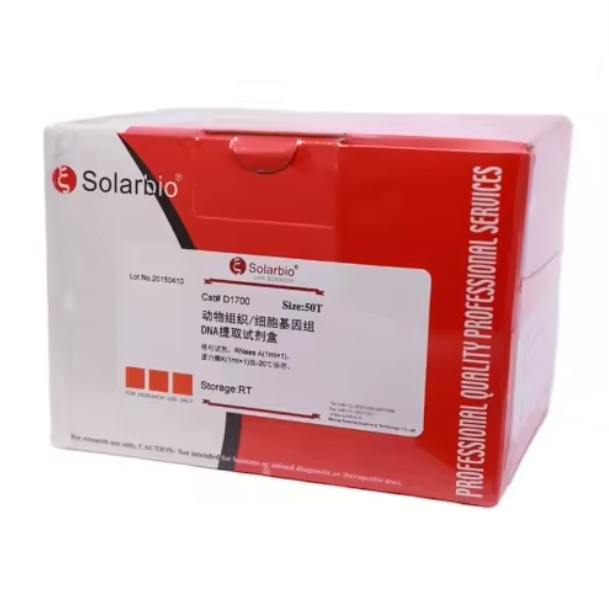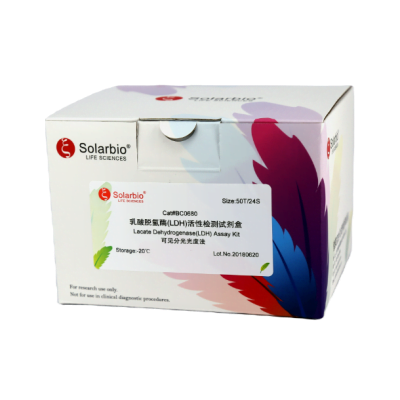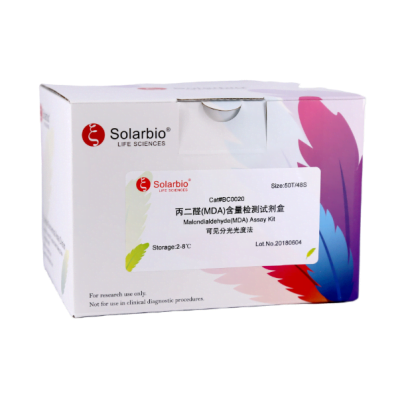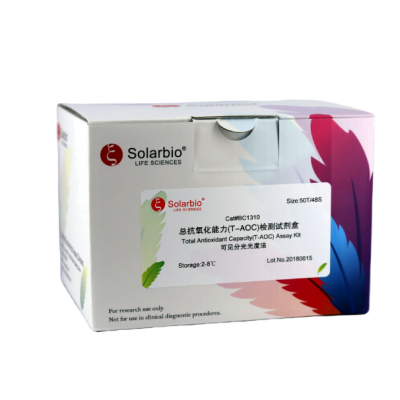Ca++Mg++-ATPase Activity Assay Kit
Nota: Prendi due o tre campioni diversi per la previsione prima del test.
Attrezzatura operativa: Spettrofotometro
Gatto n: BC0960
Misurare: 50T/24S
Componenti:
Reagente I: Liquido 30 ml×1. Conservazione a 4 ℃.
Reagente II: Liquido 4 ml×1. Conservazione a 4 ℃.
Reagente III: Polvere×2. Conservazione a -20 ℃. Dissolve thoroughly with 1 ml di acqua distillata prima dell'uso. The rest reagent can be kept at -20℃ for one week.
Reagente IV: Liquido 2 ml×1. Conservazione a 4 ℃.
Reagente V: Polvere×1. Conservazione a 4 ℃. Dissolve thoroughly with 3 ml di acqua distillata prima dell'uso. Reagente VI: Polvere×1. Conservazione a 4 ℃. Dissolve thoroughly with 15 ml di acqua distillata prima dell'uso, can be kept at 4℃ for one week.
Reagent VII: Polvere×1. Conservazione a 4 ℃. Dissolve thoroughly with 15 ml di acqua distillata prima dell'uso, can be kept at 4℃ for one week.
Reagent VIII: Liquido 15 ml×1. Storage at RT.
Soluzione standard: Liquido 1 ml×1. 10 μmol/mL standard phosphorus liquid, Archiviazione a 4 ℃.
0.5 μmol/mL standard phosphorus working solution: Dilute the 10 μmol/mL standard 20 times with distilled water to 0.5 μmol/mL standard. Per esempio: aggiungere 1.9 ml di acqua distillata a 0.1 mL of standard, mescolare accuratamente.
Phosphorus fixing reagent:
Prepare reagents for determining phosphorus content: make solution as the volume ratio of H2O: Reagente VI: Reagent VII: Reagent VIII =2:1:1:1, which should be light yellow. It shows lose efficacy if color is changed, phosphorus pollution if color is change to blue. Prepare the reagent when it will be used.
Nota: It is better to use new beakers, glass rods and glass pipettes or disposable plastic ware when making reagent to avoid phosphorus pollution.
Descrizione del prodotto:
Ca++Mg++-ATPase is widely distributed in plants, animali, microorganisms and cells, which catalyzes the hydrolysis of ATP to form ADP and inorganic phosphorus.
Ca++Mg++-ATPase decomposes ATP to produce ADP and inorganic phosphorus. The activity of ATPase can be detected by measuring the amount of inorganic phosphorus.
Reagenti e attrezzature necessari ma non forniti:
Spettrofotometro, centrifuga da tavolo, pipetta regolabile, bagnomaria, 1 Cuvetta di vetro da ml, mortaio/omogeneizzatore, ghiaccio e acqua distillata.
Procedura:
IO. preparazione del campione:
- Batteri o cellule:
Collecting bacteria or cells into a centrifuge tube, centrifugation, and discard supernatant. Suggest add 1mL of Reagent I to 5 milioni di batteri o cellule. Use ultrasonic to splitting bacteria and cells (posto sul ghiaccio, Potere ultrasonico 20%, ora di lavoro 3 secondi, intervallo 10 secondi, ripetere per 30 volte). Centrifugare a 8000 ×g per 10 minutes at 4℃ and take the supernatant on ice before testing.
- Tessuto:
Aggiungere 1 mL of Reagent I into 0.1 g di tessuto, macinazione completa su ghiaccio. Centrifugare a 8000 ×g per 10 minutes at 4℃ and take the supernatant on ice before testing.
- Siero: Directly
II. Determinazione:
- Preriscaldare lo spettrofotometro per 30 minuti, regolare la lunghezza d'onda su 660 nm, set the counter to zero with distilled water.
- Add the following reagents to EP tube:
| Reagente (μL) | Tubo di controllo (C) | Provetta (T) |
| Reagente I | 130 | 90 |
| Reagente II | 80 | 80 |
| Reagente III | 40 | 40 |
| Reagente IV | 40 | |
| Campione | 200 | |
| Mescolare accuratamente, then place the reaction solution in a 37℃ (mammifero) o 25 ℃ (altre specie) bagnomaria per 10 minuti. | ||
| Reagente V | 50 | 50 |
| Campione | 200 | |
| Mescolare accuratamente, centrifugare a 4000 ×g per 10 minutes at room temperature, prendi il surnatante. | ||
- Determination of phosphorus content, add the following reagents to 1.5 mL EP tube:
| Reagente (μL) | Tubo vuoto (B) | Tubo standard (S) | Tubo di controllo (C) | Provetta (T) |
| 0.5 μmol/mL standard phosphorus liquid |
100 |
|||
| Supernatante | 100 | 100 | ||
| Acqua distillata | 100 | |||
| Reagents for determining phosphorus content |
1000 |
1000 |
1000 |
1000 |
Mescolare accuratamente, then place the mix solution in a 40℃water bath for 10 minuti. Cooling to room temperature and detect the absorbance at 660 nm. The blank tube and standard tube just need one or two tubes.
III. Calcolo:
- Siero:
Definizione di unità: One unit of enzyme activity is defined as the amount of enzyme catalyzes the decomposed of ATP to produce 1 μmol of inorganic phosphorus per hour every milliliter of serum.
Ca++Mg++-ATPase (U/ml)=Cs×[ΔA(T)-ΔA(C)]÷[ΔA(S)-ΔA(B)]×Vrv÷s÷T
=7.5×[ΔA(T)-ΔA(C)]÷[ΔA(S)-ΔA(B)]
2. Tessuto, batteri, O cellule
- Concentrazione proteica:
Definizione di unità: One unit of enzyme activity is defined as the amount of enzyme catalyzes the decomposed of ATP to produce 1 μmol of inorganic phosphorus per hour every milligram of tissue protein.
Ca++Mg++-ATPase (U/mg prot)=Cs×[ΔA(T)-ΔA(C)]÷[ΔA(S)-ΔA(B)]×Vrv÷(Vs×Cpr)÷T
=7.5×[ΔA(T)-ΔA(C)]÷[ΔA(S)-ΔA(B)]÷Cpr
- Peso del campione:
Definizione di unità: One unit of enzyme activity is defined as the amount of enzyme catalyzes the decomposed of ATP to produce 1 μmol of inorganic phosphorus per hour, every milligram of tissue.
Ca++Mg++-ATPase (Peso U/g)=Cs×[ΔA(T)-ΔA(C)]÷[ΔA(S)-ΔA(B)]×Vrv÷(Vs÷V1×W)÷T
=7.5×[ΔA(T)-ΔA(C)]÷[ΔA(S)-ΔA(B)]÷W
- batteri o cellule
Definizione di unità: One unit of enzyme activity is defined as the amount of enzyme catalyzes the decomposed of ATP to produce 1 μmol of inorganic phosphorus per hour every 10000 cells or bacteria.
Ca++Mg++-ATPase (Cella U/104 )=Cs×[ΔA(T)-ΔA(C)]÷[ΔA(S)-ΔA(B)]×Vrv÷(Vs÷V1×500)÷T
=0.015×[ΔA(T)-ΔA(C)]÷[ΔA(S)-ΔA(B)]
Cs: Concentrate of standard tube, 0.5 µmol/ml;
Corda: Volume totale di reazione, 0.5 ml; Contro: Volume del campione, 0.2 ml;
Cpr: Concentrazione proteica del campione (mg/ml); T: Tempo di reazione (min), 1/6 ora;
W: Peso del campione (G);
Vl: Volume of reagent I, 1 ml;
500: The amount of bacteria or cell, 5 milioni.
Nota
- This kit can detect 24 tubes of Ca++Mg++ -ATPase samples in 50 tubes for each sample need one tube as control.
- This method has the characteristics of trace, sensitive and rapid. The test tubes used for determination are phosphate-free strictly. Avoiding phosphorus pollution is the key to the success of detection.
Esempio sperimentale:
- Take of pancreas and add 1 mL of Reagent I for ice bath homogenization. After centrifugation at 4℃ for 10 min, the supernatant is put on the ice and operated according to the determination steps. ΔAT = 0.916-0.389=0.527, ΔAS =0.398-0.004=0.394
Ca++Mg++- ATPase activity (Massa U/g) = 7.5 × ΔAT ÷ΔAS ÷ W = 100.32 Massa U/g.
- Take 0.1g of willow and add 1 mL of Reagent Ⅰ for ice bath homogenization. After centrifugation at 4℃ for 10 min, the supernatant is put on ice and operated according to the determination steps. The ΔAT=0.137-0.124=0.013, and the ΔAS=398-0.004=0.394
Ca + + Mg + + – ATPase activity (Massa U/g) = 7.5×ΔAT ÷ ΔAS ÷ W = 2.47 Massa U/g.
Riferimenti
[1] Datiles M J, Johnson E A, McCarty R E. Inhibition of the ATPase activity of the catalytic portion of ATP synthases by cationic amphiphiles[J]. Biochimica et Biophysica Acta (BBA)-Bioenergetics, 2008, 1777(4): 362-368.
prodotti correlati
BC0060/BC0065 Na+K+ — ATPase Activity Assay Kit
BC0300/BC0305 ATP Activity Assay Kit






Recensioni
Non ci sono ancora recensioni.